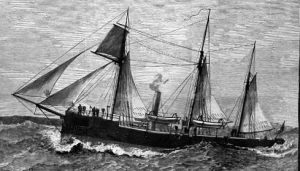The Wreck of HMS Wasp, 1884
An accidental victim of Ireland’s “Land War”
Though it is likely that many in her crew disliked the task assigned them it is fair to say that the mission on which HMS Wasp was engaged at the time of her loss was one of the most inglorious ever undertaken by the Royal Navy.
HMS Wasp under sail and steam
Built in the 1880-82 period, HMS Wasp was one of the 11-strong Banterer Class of gunboats. They were of composite construction, based on an iron frame but planked with wood, thus facilitating fitting of anti-fouling coppering. This was an important, if not to say essential, feature for ships which were to see considerable colonial and tropical service. They were 125 feet long, and displaced 465 tons. A single-screw 360 HP compound steam engine gave a top speed of a mere 9.5 knots but for the sort of service such vessels were intended endurance was a more important consideration than speed. A barquentine rig was carried on three masts to supplement the engine, or indeed to replace it on long voyages to conserve coal. For their size these vessels carried a heavy armament – two 6-inch 64-pounder muzzle-loading rifles, supplemented by two 4-inch breech-loaders as well as small-calibre Maxims, Gardners or Gatlings. The unsophisticated 6-inch weapons, were effective enough for shore bombardment and the vessel’s small size and sailing ability made them useful for colonial duties, for which armour was not required. The crew consisted of 60 officers and men. This is an indication of just how many men were employed in the Navy at this time – this single class of small gunboats alone required almost 700 men to crew them.
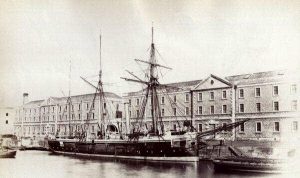
HMS Wasp – looking pristine, probably soon after commissioning
 After commissioning, HMS Wasp was based at based in Queenstown (now Cobh) in County Cork in the south of Ireland, then still under British rule. Her duties appear to have fishery and lighthouse inspections or other official duties around the entire Irish coast. These were difficult and bitter years in Ireland, where the long and often violent social unrest known as the “Land War” was raging. Small tenant farmers were, at last, confronting the landlords – almost exclusively Anglo-Irish and different from them in religion and political affiliation – on issues of tenure and fair rent and were demanding distribution of land to them. Particular bitterness was felt towards absentee landlords who lived well elsewhere on the rents and who ploughed little back into the betterment of local society. Though the overall poverty of the country was not as extreme as during the Great Famine period of the 1840s, life was still miserably deprived for many in the rural population. A poor harvest could mean inability to pay rent and such failure frequently resulted in eviction of entire families, followed by demolition by battering ram of the dwelling to prevent its further occupation. Such evictions saw deployment of armed police to protect the bailiffs and demolition gangs – photographs of such occasions are heartrending in their pathos. Feelings ran high and there was a high level of violence on both sides. It was in this period that the “Boycott” weapon came to have its present meaning since the process was named from action used against a Captain Boycott, the agent of a particularly unpopular landlord.
After commissioning, HMS Wasp was based at based in Queenstown (now Cobh) in County Cork in the south of Ireland, then still under British rule. Her duties appear to have fishery and lighthouse inspections or other official duties around the entire Irish coast. These were difficult and bitter years in Ireland, where the long and often violent social unrest known as the “Land War” was raging. Small tenant farmers were, at last, confronting the landlords – almost exclusively Anglo-Irish and different from them in religion and political affiliation – on issues of tenure and fair rent and were demanding distribution of land to them. Particular bitterness was felt towards absentee landlords who lived well elsewhere on the rents and who ploughed little back into the betterment of local society. Though the overall poverty of the country was not as extreme as during the Great Famine period of the 1840s, life was still miserably deprived for many in the rural population. A poor harvest could mean inability to pay rent and such failure frequently resulted in eviction of entire families, followed by demolition by battering ram of the dwelling to prevent its further occupation. Such evictions saw deployment of armed police to protect the bailiffs and demolition gangs – photographs of such occasions are heartrending in their pathos. Feelings ran high and there was a high level of violence on both sides. It was in this period that the “Boycott” weapon came to have its present meaning since the process was named from action used against a Captain Boycott, the agent of a particularly unpopular landlord.
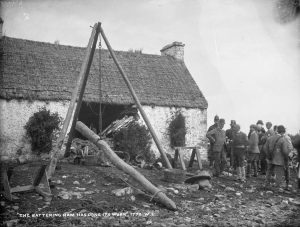
Demolition of tenant’s house by battering ram following eviction in the 1880s to prevent reoccupation. (Note that the tenants attempted to defend themselves by stuffing gorse in the windows as a primitive alternative to barbed wire)
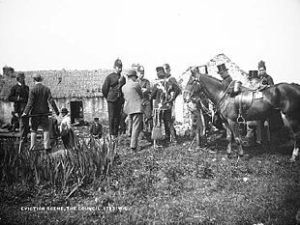
A landlord or his agent overseeing eviction with police support. Note the lady on the horse to the right viewing the spectacle. Scenes like this sowed seeds of bitterness that ultimately led to independence.
Poverty was possibly at its worst on the small islands off the North and West Coasts. The most extreme case was perhaps Inishtrahull, a tiny speck which is the most northerly island of all. all. Six miles from the mainland, it is the most northerly point in the Irish Republic. Though uninhabited now, the last residents having left in 1929, the island supported several families in the 1880s as well as a lighthouse.
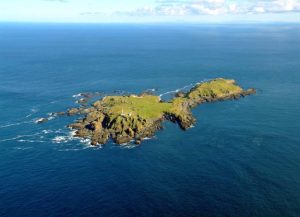
Inishtrahull – The Irish Republic’s most northerly point. (Photograph by author Kevin Dwyer http://blog.discoverireland.com/2010/09/the-joys-of-aerial-photography-over-ireland/)
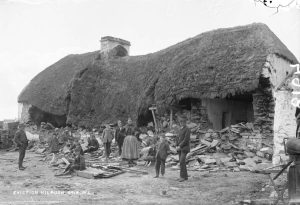
The battering ram’s work: a house left uninhabitable post-eviction. For many of those cast on the roadside, the best option would be to go to the United States if they could raise the money.
Difficult as life on Inishtrahull may have been, rent still had to be paid for the pitiful plots of land, basic humanity not always being a characteristic of the landlord class. In September 1884 three families on Inishtrahull were unable – or perhaps unwilling – to pay their rents and an example had to be made of them. HMS Wasp, then at Westport on the West Coast, and under the command of the 39-year old Lieutenant J. D. Nicholls, was accordingly ordered to Moville, the mainland village closest to the island. Here she was to take on board the bailiffs, police and other officials who would carry out the evictions. One can well imagine distaste among many of the gunboat’s crew for this task, but orders were orders.
In the early hours of September 22nd HMS Wasp was following a course that took her between the northwest coast of Donegal and the rocky coast of Tory Island, nine miles offshore. The vessel was under sail only, and the boiler was not fired, so that the advantage of improved maneuverability which steam would provide# was not available. Given this fact it was surprising that HMS Wasp would have followed the course that took her to the east of Tory Island, between it and the mainland, rather than gaining greater sea room had she sailed west of it. It also appears that Nicholls and other officers may have been sleeping.
 HMS Wasp on the rocks beneath the Tory Island lighthouse
HMS Wasp on the rocks beneath the Tory Island lighthouse
At 0345 the Wasp ran onto rocks directly under the Tory lighthouse. She sank within 30 minutes with the loss of fifty of the crew, leaving only six survivors. Only the mastheads were left protruding from the water and it was to these that the survivors clung. They were rescued by the islanders and sheltered until they could be picked up four days later by another ship assigned to Irish duty, HMS Valiant, which took them to the mainland. Valiant was a large Hector-class armoured frigate of 7000 tons, this class being smaller versions of HMS Warrior, which can be seen in Portsmouth today. A monument was erected in the churchyard of St. Ann’s, Church of Ireland Church, Killult, on the mainland coast opposite Tory Island, where some of the sailors are buried.
A Royal Navy enquiry subsequently found that HMS Wasp was lost “in consequence of the want of due care and attention…” but no one person was singled out for blame, possibly in view of the deaths of the officers and the distress it would inflict on their families. Apart from the questions raised about what was happening on board HMS Wasp, much debate since has focused on whether the Tory light was on or off before the vessel struck the rocks. What is known is that the light was certainly on after the collision. However, the question remains – was the light on when HMS Wasp was nearing Tory? Did animosity towards the British rulers of Ireland at the time and the duties in which HMS Wasp was sometimes involved cause the light to have been extinguished deliberately when the gunboat was passing through the channel between the island and the mainland?
Another less likely explanation, but one which became popular in the area was that HMS Wasp was the victim of a curse laid on it via “Cursing Stones” on the island. These are Neolithic remains involving individual stones resting in a larger cup-shaped one. Of all the speculative explanations of the tragedy, this is the one that can most easily be ruled out!
The latest Dawlish Chronicles novel has been published:
Britannia’s Rule
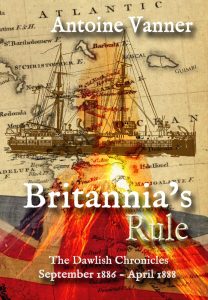 1886: Captain Nicholas Dawlish, commanding a flotilla of the Royal Navy’s latest warships, is at Trinidad when news arrives of a volcanic eruption on a West Indian island. The situation is worsening and only decisive action can avert massive loss of life. He races there with his ships to render help. His enemy will be an angry mountain, vast in its malevolent power, a challenge that no naval officer has faced before.
1886: Captain Nicholas Dawlish, commanding a flotilla of the Royal Navy’s latest warships, is at Trinidad when news arrives of a volcanic eruption on a West Indian island. The situation is worsening and only decisive action can avert massive loss of life. He races there with his ships to render help. His enemy will be an angry mountain, vast in its malevolent power, a challenge that no naval officer has faced before.
But Dawlish’s contest with the volcano is just the prelude to a longer association with the island. Its sovereignty is split – a British Crown Colony in the west, and in the east an independent republic established seven decades earlier by self-emancipated slaves. When wrenched from France through war, both seemed glittering economic prizes. Now they are impoverished backwaters where resentment seethes and old grudges fester. For many, the existence of a ‘black republic’ is resented, an affront to be excised. In France, a man of limitless ambition, backed by powerful interests, sees the turmoil as an opportunity that could bring him to absolute power. And, if he succeeds, perhaps trigger war in Europe on a scale unseen since the fall of Napoleon.
Through this maelstrom, Nicholas Dawlish must navigate a skillful course. Political concerns complicate challenges that can only be resolved by ruthless guile and calculated use of force. Lacking direct support from the Royal Navy, Dawlish must fight some of the most vicious battles of his career with inadequate resources and unlikely – and unreliable – allies.
Available in Paperback and Kindle (also readable on smartphones and tablets via Kindle App).
Kindle Unlimited Subscribers can read it, or any of ten other Dawlish Chronicles, at no extra cost.
For more details and for ordering, click below:
For amazon.com For amazon.co.uk For amazon.com.au For amazon.ca
The Dawlish Chronicles – now up to eleven volumes, and with more still to come!
Click on the image below for details of the individual books
Six free short-stories are available for download to your Kindle or Smartphone. Access them by registering for the Dawlish Chronicles mailing list – just click on the banner below. It will update you on new books and provide other free stories at intervals.


